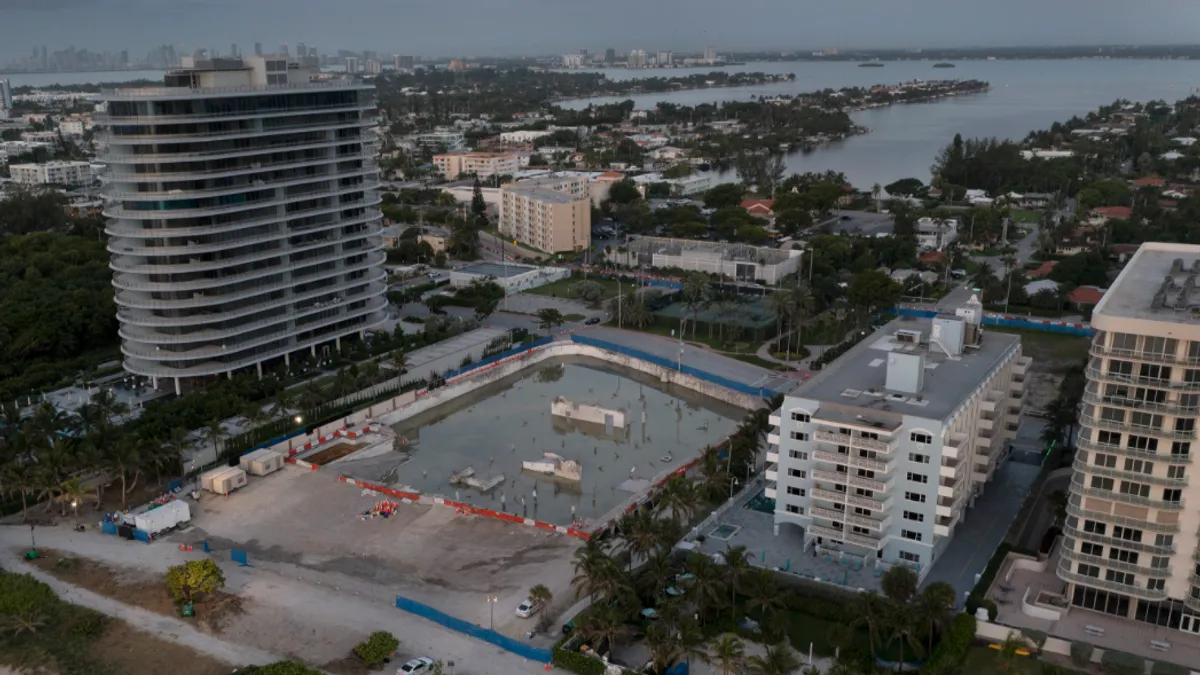Dive Brief:
- DAMAC Properties, a Dubai-based luxury real estate developer, has agreed to pay $120 million for the site where 98 people died in June when the Champlain Towers South residential tower collapsed in Surfside, Florida.
- Owned by billionaire Hussain Sajwani, who is known as the “Donald Trump of the Middle East,” DAMAC set the $120 million minimum bid for the nearly 2-acre beachfront property last year. When no competing bids were submitted by last Friday’s deadline, an auction scheduled for May 24 was canceled.
- DAMAC told The Real Deal it plans to build a luxury residential tower, likely a for-sale condo project, on the site.
Dive Insight:
While DAMAC will face some touchy issues with survivors’ families and cleanup of the site, construction and engineering experts say the problems that caused Champlain Tower South to collapse were in the design and maintenance of the building.
The site itself is buildable and safe, experts say.
“From a technical standpoint, there are no big obstacles,” says Roberto T. Leon, a structural engineering and materials professor at Virginia Tech. “There are probably some foundations there that they will leave in place or build around. They may re-utilize them to some degree, but I think they’re probably just going to start from scratch.”
Though geotechnical engineering reports on the site haven’t been released, New York City-based attorney Carol Sigmond, a partner in the construction and litigation practice groups at Greenspoon Marder LLP, said no developer would pay $120 million to buy a property without having the soil probed to make sure it’s stable.
“[Sajwani] has to know what he’s facing,” she said. “He’d never spend that kind of money without having that type of basic information. He has to believe he can get a foundation in.”
But attorney Tyler Berding, a founding partner of Berding & Weil LLP, who has litigated numerous building product and construction failures in Florida and elsewhere is not convinced the site is stable. A National Institute of Standards and Technology investigation into the exact cause of the collapse is ongoing, but an academic study found the building had been sinking 2 millimeters per year since the 1990s as the ground below it, once a marshland, settles.
“The land itself has some serious issues,” Berding said. “This isn’t just that lot, but that whole coast of Florida that’s being invaded by seawater. Certainly, the city of Surfside and, I would hope, the state of Florida would want some serious engineering done on that site before they allowed them to build another high rise there — just simply because what they’re building on is not very stable ground. It’s sand being invaded by seawater.”
Other potential issues
Peter Dyga, president and CEO of the Florida East Coast chapter of Associated Builders and Contractors, said the only potential issue he sees is that toxic materials and liquids from the collapsed building may have leached into the ground.
“You just want to make sure the ground itself doesn’t come with any liability from a cleanup perspective,” he told Multifamily Dive.
That includes human remains, Sigmond said, which could cause some pushback from victims’ families.
“The only thing we really have to compare this to is the World Trade Center,” Sigmond said, and that site was challenging because workers kept coming across body parts as it was redeveloped.
“He’s going to have some pushback from families of the dead,” Sigmond said. “If he’s smart, he’ll have a protocol with the city to have the coroner come any time they find remains. The coroner will come to recover the remains in a respectful way and identify who they are. … And if he’s smart, he’s going to put some kind of memorial on the site.”
Whatever gets built, Dyga said, “must be done respectfully so we never forget.” He suggested waiting to build “until the wounds are perhaps a little less raw.”
Moving forward
Some of the victims’ family members have pushed for a memorial rather than new construction on the site, but the land sale is contributing $33 million to an $83 million settlement for unit owners and their heirs who lost their property in the collapse.
In addition, victims’ families reached a $997 million settlement earlier this month with insurance companies and developers of an adjacent building, where victims and survivors allege vibrations from excavation and construction contributed to Champlain Towers South’s collapse.
DAMAC should be aware of those allegations so it doesn’t face similar criticism when it begins construction on its own building, Leon said. “I think the neighbors are going to be paying a lot of attention.”
In September 2021, an appraiser valued all the condos in Champlain Towers South, if they had sold on the day before the crash, at $95 million, Newsweek reported.
The offering memorandum for the property shared with Multifamily Dive says its “permissive” zoning allows for a potential 12-story, 120-foot-high residential or hotel tower with 200 feet of direct beach frontage.
“With South Florida’s Atlantic coastline virtually fully developed, opportunities to acquire developable sites of scale are extremely rare and in high demand,” the memo states.
“It appears he really wanted the property,” Sigmond said, pointing out that “anything in Florida is hot right now.”









